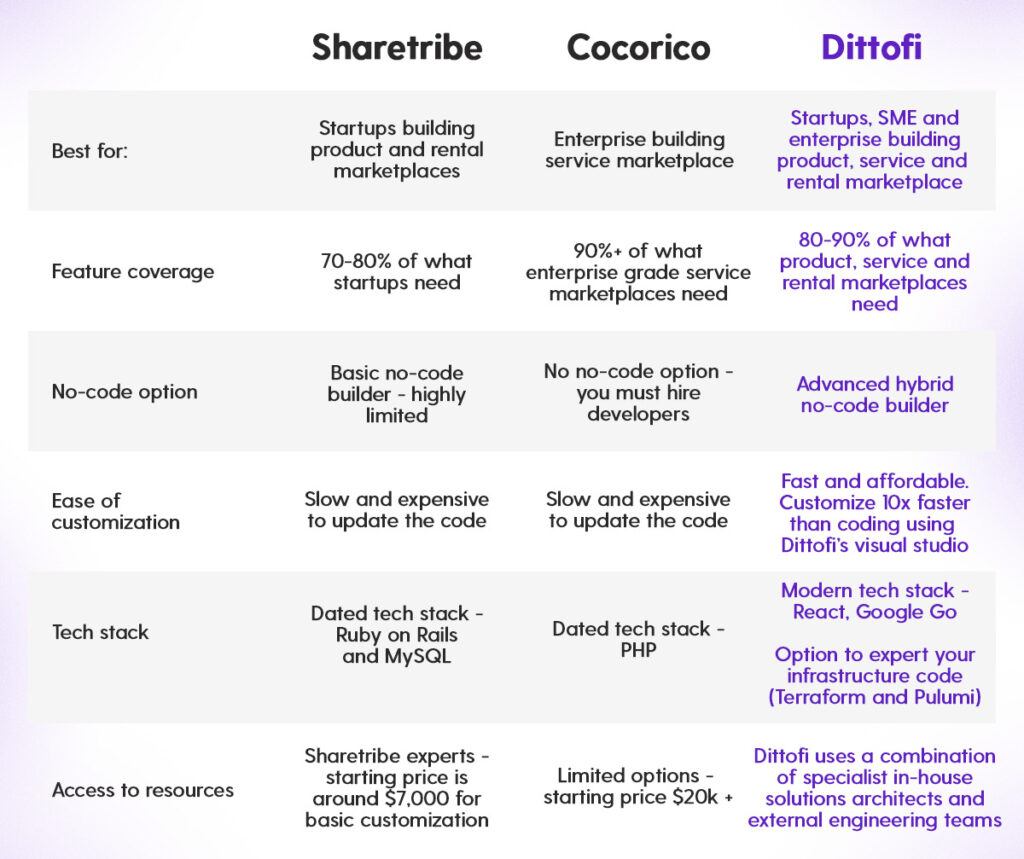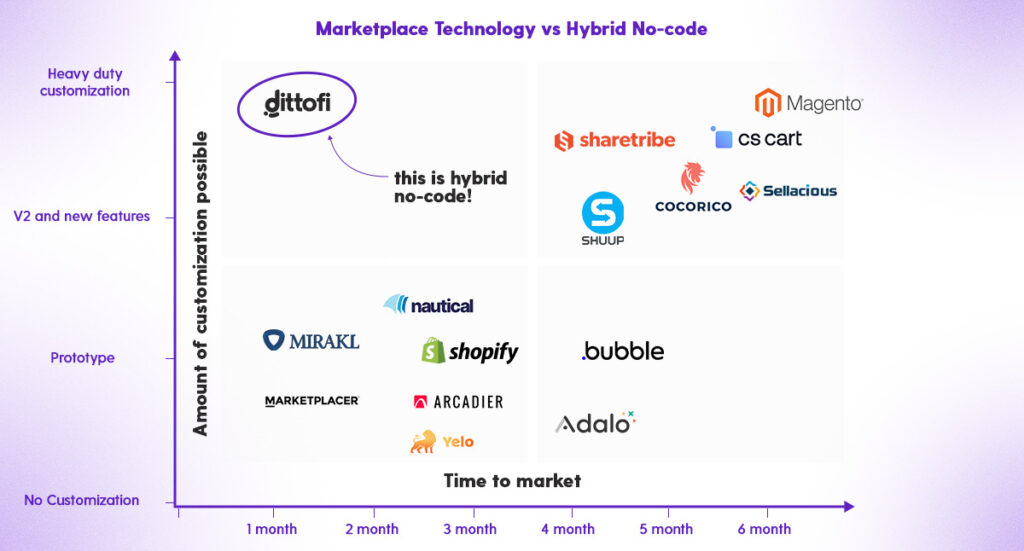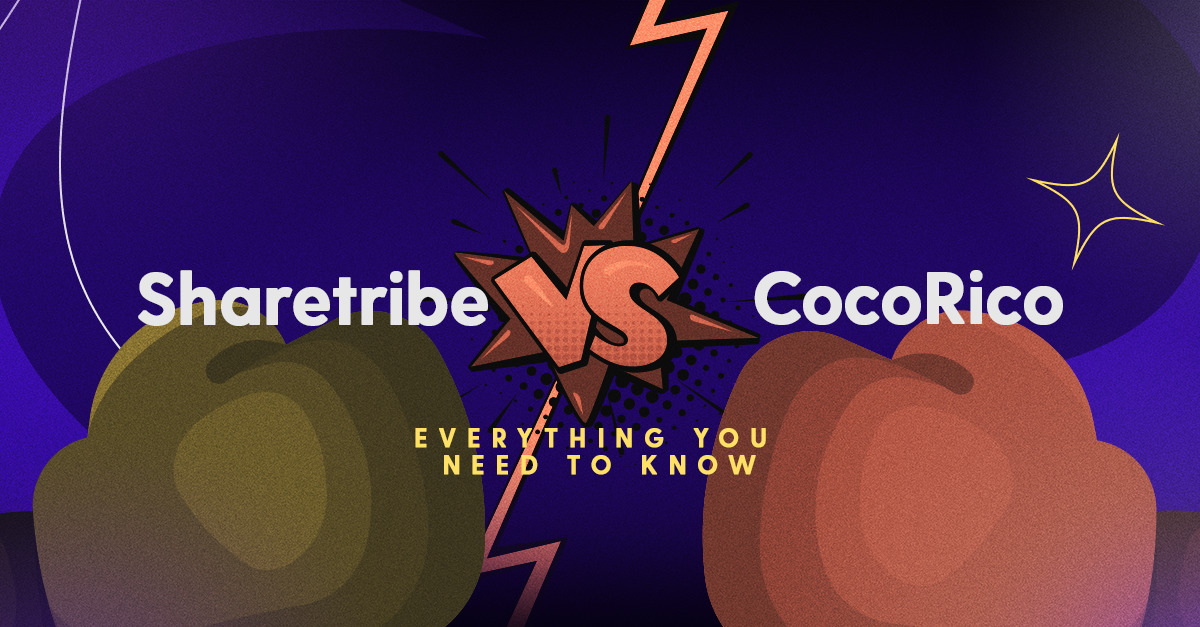Building a two sided marketplace from scratch is not for the faint of heart.
There is a huge amount of complexity.
For instance, how will you design your marketplace transaction flow? How do you implement payment gateways in a PCI compliant way? How can you design your frontend to maximize the efforts from your digital marketing team? What about marketplace hosting?
The list goes on and on and on…
Luckily, there are several open source marketplace technologies that you can learn from and leverage to speed up your marketplace development. Two popular tools are Sharetribe and Cocorico. Each of these tools is built on a different tech stack and serves a slightly different use case.
In this article we help you choose between Sharetribe vs Cocorico. We also cover a new and more advanced way of building and maintaining marketplaces using hybrid no-code tools.
First up though, let’s take a look at what exactly is Sharetribe.
What is Sharetribe?
Sharetribe is an open source marketplace technology that you can leverage to build a peer to peer marketplace (product, service or rental). The Sharetribe solution includes 70% – 80% of the must-have p2p marketplace features. This includes features like the ability to sign up new users, manage listings and, critically, a two sided marketplace transaction flow.
Whilst Sharetribe allows you to build p2p marketplaces in the product, service or rental categories, the platform lacks several important features that are needed for each category such as, option to create subscription based marketplace, reverse marketplaces and so on.
Although Sharetribe has some missing features this should not be a reason for developers to dismiss the technology. There are still tremendous advantages that can be gained from using the open source marketplace technology as a foundation to start your development from.
How developers use Sharetribe
Sharetribe developers are able to take the following three paths to develop a marketplace:
- Use Sharetribe’s no-code marketplace dashboard to configure a marketplace
- Connect custom built frontend code to the Sharetribe API and host your data and backend code with Sharetribe directly.
- Download the code for Sharetribe’s marketplace API directly from Github, take this code and deploy it onto your own environment for an entirely custom setup.
There are obvious benefits to each of these approaches, which can be useful for companies with different amounts of resources and who are at different stages of their marketplace development.
For instance, startups with limited resources can use Sharetribe’s no-code marketplace dashboard to build and launch a standard p2p marketplace. Whilst customization options using Sharetribe’s no-code marketplace dashboard are highly limited, companies with more resources can hire engineers to customize Sharetribe’s source code in order to develop an entirely custom marketplace.
What is Cocorico?
Cocorico is another open source marketplace technology. The solution was developed by Cocolabs, a French based development agency that specializes in marketplace development. The solution includes a suite of features primarily focused on service based marketplaces. This includes features such as integrated events calendars, booking management, location tracking, client verification and so on.
How developers use Cocorico
Different from Sharetribe, Cocorico only has one way to deploy. This is to download the source code from their Github repository.
The code base is extensive and there are many things that you can learn by reading how Cocorico has been designed. That being said, the code for Cocorico is written in PHP and therefore you will need a PHP developer to read the code and understand what features are there before you can start to customize it.
Since Cocorico is so extensive, it can take a lot of time to read and understand all of the functionality that is there. As such it is best to hire a company that already knows Cocorico. This will save a lot of time in learning how the solution works.
Sharetribe vs Cocorico: A quick comparison
Below is a quick comparison of Sharetribe vs Cocorico. We also include a Dittofi’s more modern, hybrid no-code approach to marketplace development. This will give you a clear comparison of Sharetribe vs Cocorico vs Dittofi.
For more information on Dittofi and our marketplace specialists, check out Dittofi’s no code marketplace solution.

Key differences between Sharetribe vs Cocorico
Both Shareribe and Cocorico are two popular open source marketplace technologies. However, there are some key differences in Sharetribe vs Cocorico that we will briefly go through now.
1. Feature coverage
Cocorico is one of the first marketplace technologies to be developed. Therefore in a comparison between Sharetribe vs Cocorico, it is no surprise that Cocrico has better feature coverage.
Both Sharetribe and Cocorico support product, service and rental marketplaces. This is since they include features such as built-in payments systems, tools for managing product catalogues, order and category management, custom branding, search and filtering and so on. Cocorico meanwhile also includes features such as geolocation tracking, geofencing, fee and commission management and the option for a multi vendor shopping cart (a very complex feature in marketplace development).
Therefore, Cocorico has the edge on a feature to feature comparison. However, just because Cocorico has more features it does not guarantee that it is the right solution for you. This is because many features means much more complexity to set up, manage, customize and maintain. Oftentimes it is better to start small and layer in new features over time so as to not overwhelm yourself and your team. Therefore, your choice of Sharetribe vs Cocorico depends on your specific use case.
2. No-code option
Sharetribe has a no-code option for non-technical teams to start building a marketplace immediately. Cocorico does not have a no-code option.
Whilst Sharetribe’s no-code builder is highly limited in functionality, it can be useful for non-technical teams to quickly test and validate their ideas for new marketplaces. Teams with limited resources can use Sharetribe’s no-code platform to build a “somewhat” custom marketplace. Once your marketplace has been validated, you can then hire a marketplace developer and look to build a truly custom marketplace.
A subtle nuance here is that any customizations you make using Sharetribe’s no-code marketplace cannot be exported. So you will need to re-implement these changes with code once your idea has been validated. For more advanced no-code marketplace development, check out Dittofi’s hybrid no-code option below.
3. Ease of customization
To customize Sharetribe and Cocorico marketplaces, you will need a marketplace developer. Whilst it is true that Sharetribe has a no-code solution, this is too limited to build a custom marketplace. Whenever code customization is required, development immediately becomes slow and time consuming. Code edits with Sharetribe or Cocorico are no exception.
Making changes to Sharetribe’s code is, on the balance of things, easier than with Cocorico. This is since the Sharetribe codebase contains less features and is therefore easier to wrap your head around. It also includes more up to date documentation and it developed using Ruby on the Rails which is also easier to edit than Cocorico’s PHP code.
In contrast to both Sharetribe and Cocorico, more modern marketplace technologies like Dittofi come with extensive visual development tooling. These technologies allow you to make extensive customizations to your marketplace technology without coding and 10x faster. We talk more about these solutions below.
4. Tech stack
When looking at open source marketplace technologies, it’s impressive to consider technologies are actually used. This will help you know what skill sets you’re going to need in order to manage and maintain the solutions.
Sharetribe is built on the following technologies:
- Frontend: React + jQuery
- Backend: Ruby 3.2.2 and Ruby on Rails 6.1.7.3
- Database: MySQL 8.0
- Amazon S3: for image hosting
Check out Sharetribe’s github account for more information.
By contrast Cocorico uses the following:
- Frontend: HTML, CSS and JavaScript
- Backend: PHP
- Database: PostgreSQL
Check out Cocorico’s github account for more information.
Realistically, both of these tech stacks are dated and neither support the export of their hosting configuration.
For a more modern alternative, with the option to export an advanced infrastructure configuration, check out Dittofi which uses the following technologies:
- Frontend: React
- Backend: Google Go
- Database: PostgreSQL
- Hosting: Terraform, Pulmi, with the option to export Dittofi’s Amazon Web Service configuration to your own AWS account.
For more details on the benefits of Google Go vs Ruby on the Rails, read Google Go vs Ruby on the Rails, a business perspective.
5. Access to resources
Let’s face it, you’re going to eventually need to hire a team of developers to help customize your two sided marketplace. For this to work, you’re going to need to make sure that there is a ready pool of software engineers that you can choose from. Ideally these developers will have experience building or working on a two-sided marketplace and have experience in part or all of the technology stack that you’ve used to build your marketplace.
In the question of Sharetribe vs Cocorico, you can also look for engineers who have experience on these codebases directly. This will help lower the time to onboard new engineers onto the code base, help them get productive faster and enable you to gain insights from their past experience.
Cocorico has a really limited community, although you can go to Cocolabs who created this platform for resources. By contrast, Sharetribe has a much more active community and therefore it is easier to find Sharetribe developers. However, Sharetribe is written in Ruby on the Rails and this language tends to attract developers with less experience.
Other open source solutions: Hybrid no-code
Building a custom marketplace with Sharetribe and Cocorico is expensive and time consuming. Whilst it is true that both of these solutions come packed full of features, you will need to hire engineers in order to setup and customize the solution for your specific use case. Customization is slow and time consuming, since you will be working directly with custom code.
By contrast, platforms like Dittofi’s hybrid no-code platform allow you build a custom marketplace in an entirely visual way and 10x faster than traditional coding. The way Dittofi works is, you take one of our open source marketplace templates, install this template into our visual development studio and then work from within the visual development studio to customize the platform. All of your visual edits are then transformed into enterprise grade code (React and Google Go), that you can deploy in a single click or export and hand off to developers.
Using Dittofi you are able to launch a custom marketplace in under one month and then customize your solution 10x faster than Sharetribe or Cocorico.
The graph below shows how hybrid no-code is positioned relative to Sharetribe vs Cocorico and other marketplace technologies. With hybrid no-code, development teams can build and launch a custom, enterprise grade marketplace in as little as 1 month. From there, you can continue iterating on your marketplace without any limitations.

Conclusion: Sharetribe vs Cocorico, which is right for you?
Nowadays, there are a lot of different open source marketplace technologies.
From our analysis here, you can see that Sharetribe is better suited for startups operating on a low budget. Whilst it does not include the depth of features available with Cocorico, this makes it easier for new engineers to read the Sharetribe code base, learn how it works and start to adapt it. By contrast, if you already have access to Cocorico developers and a larger budget, Cocorico is a more power solution on a feature by feature comparison.
Customizing both Sharetribe and Cocorico requires working with custom code. As everyone knows, coding is expensive and time consuming. By contrast, using a hybrid no-code platform, such as Dittofi can help you to build your marketplace fast, customize rapidly, without coding.
If you’d like to learn more about which solution Sharetribe vs Cocorico is better for you. Check out some more of our marketplace technology comparison articles below.
To try out Dittofi’s marketplace solution, you can sign up to Dittofi on a 14 day free trial or schedule a demo to learn what features are included within our marketplace templates and how you can use hybrid no-code to adapt these for your specific use case.
Become a Marketplace Insider
Join our inner circle for exclusive insights, coveted trade secrets, and unparalleled strategies – your journey to marketplace dominance begins here.

